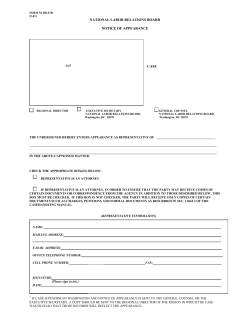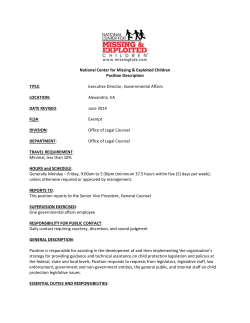
Why Every Lawyer Should Understand the Importance of Enterprise Risk Management
Why Every Lawyer Should Understand the Importance of Enterprise Risk Management 1 November 20, 2012 EILEEN GARCZYNSKI, ESQ. DAVID I. GREENBERG, ESQ. What is Risk? 2 “Risk is the uncertainty caused by the occurrence of an event that might affect the achievement of objectives.” “Risk comes from not knowing what you're doing” ― Warren Buffett Severity of Malpractice Claims is Steadily Increasing The number of large claims has risen sharply. Nearly all the insurers have seen an increase in the number of claims with a reserve (including loss and expenses) of more than $500,000 in 2012. Increased severity can be attributed to various factors. An obvious one is the sheer magnitude of the transactions or of the underlying matters law firms are working on. Given the $500,000 or greater yardstick, increased defense costs can also play a role. Large Claim Payouts Have Increased The share of claims resulting in multi-million dollar payouts has grown exponentially. Four of the six insurers indicated their company had paid or had participated in paying a claim of $100 million or greater and another had a payment between $50 million - $100 million. Largest Number of Claims Come from Three Main Practice Areas ü Real Estate ü Corporate & Securities ü Business Transactions A&G Survey Shows Conflict of Interest Most Common Error Five of the six insurers cited conflict of interest as either the first or second most frequent cause of malpractice claims. Two listed failure to calendar or follow-up as first or second. What is ERM? 7 Enterprise Risk Management (ERM) provides a framework for risk management, which typically involves: (1) Identifying particular events or circumstances relevant to the firm’s objectives (risks and opportunities); (2) Assessing them in terms of likelihood and magnitude of impact; (3) Determining a response strategy; and (4) Monitoring progress. By identifying and proactively addressing risks and opportunities, business enterprises protect and create value for their shareholders, employees, and clients. ERM Cycle 8 (1) Identifying Law Firm Risks 9 Top Five Risks Identified as Facing Law Firms (Order of Severity) § Bankruptcy or acquisition of significant clients § IT security § Pressure on fees § Conflicts of Interest § Errors made by staff/lawyers on complex, high-value transactions. - Insurance Journal 2009 (1) Identifying Law Firm Risks 10 Identifying Risks Can Be Done In a Variety of Ways Risk Workshop Pros: Good way for participants to share views and create enriched discussions. Popular due to efficient use of time and sharing opportunities. Cons: High level of facilitation skills required. Voting required. Limited by geography. Structured Interview Pros: Creates conversations; face-to-face contact promotes ERM culture Cons: Limited by geography. High level of interview skills required. No opp. For dialogue among fellow colleagues. Formal Survey Pros: Can cover a larger number of participants; well documented. Cons: Quality of responses can be an issue. No conversations – opp. for sharing lost. Prep time. (1) Identifying Law Firm Risks 11 Risk Types Practice Management Financial Example Risks Professional Responsibilities (including malpractice, conflicts, litigation support); Professional Development Risks; Managing the Engagement (Engagement/Disengagement/Non-Engagement/Scope of Engagement); Client Relations; Bad Clients; Lateral Issues, Rogue Lawyers; etc. Transparency and Disclosure; Internal Controls; Anti-Money Laundering; Credits; Firm Investments; Portfolio Risks; Audits; Bankruptcy or acquisition of significant clients; Pressure on Fees, etc. Key Roles Practice Leaders, Management Committee, General Counsel or Legal Officer; Directors of Conflicts, Litigation Support, Library, Knowledge Manager, Records Manager CFO, Practice Leaders Strategic Reputational, Marketing, Markets, etc. Managing Partner, General Counsel Firm Governance Firm processes; customs, policies, committees, management structure, etc. Management Committee, Managing Partner, General Counsel IT/Cyber Confidentiality, Data Security & Ethical Walls, Data Recovery, Issues with Third Party Suppliers and Outsourcing. CIO, Technology Manager, General Counsel Operational Employment (Talent – Lateral and New Hires), Fraud, Damage to Assets, etc. Environmental Natural Disasters, Epidemics, etc. HR, COO, General Counsel, Management Committee COO (2) Assess Likelihood Using Key Risk Indicators 12 Financial Risk Practice Management Cyber KRI # 1: > % loss in firm revenue KRI # 1: 2 + Open Malpractice Claims KRI # 1: Outdated Software KRI # 2: Open Line of Credit KRI # 2: Non-use of Engagement & Disengagement Letters KRI # 2: iPads; Thumb drives; etc. KRI # 3: Compensation Commitments KRI # 4: __% of clients = __% revenue KRI # 5: # Account Receivables > 90 days KRI # 6: Unfunded Pensions KRI#7: Insufficient Insurance Limits KRI # 3: Outdated Conflict System KRI # 4: Outdated Client Intake Procedures KRI # 3: Inadequate Cyber Ins. KRI # 4: Unsecured Conferencing System KRI# 5: Zero use of Ethical Walls (3) Determining A Response Strategy 13 Role & Composition of Executive Leadership in Oversight and Implementation ¡ ¡ ¡ Provide a Holistic top-down view of risks faced by the firm Reinforcement of transparent, firm-wide view of risk management Encourage firm culture (‘tone @ the top’) of ERM awareness in everyday decision making Dedicated Oversight/Audit Committee ¡ ¡ ¡ ¡ Diverse Group Trained on firm’s fundamental operations Relevant Industry Expertise Report on strategies, procedures, implementation and success of ERM process both across the organization and upward to the leadership. (3) Future: Risk Register/ERM 14 # The Risk: What can Happen and How Can it Happen The Consequences of an Event Happening Adequacy of Existing Controls Consequence Rating Likelihood Rating Level of Risk Risk Priority Monitoring Progress 15 Evidenced By Solid Firm Governance/Culture Ø Collegial Environment Ø Selective Lateral Hiring Ø Low Partner Turnover Ø Well written/executed Partnership and Management Agreement/Plan Financial Strength ü Small or no Line of Credit ü Varied client base ü Frequent and timely billing ü No unfunded pensions ü No compensation commitments Monitoring Progress 16 Evidenced By v Strong Client Intake System Practice Management v Conflict Avoidance Procedures/Walls v No Outside Interests v No Suits for Fees v Engagement/Disengagement/Non- Engagement Letters v No Malpractice Claims v CLE Requirements met Operational v Strong institutionalized long-term clients preferred v Lateral Hire/Talent Management Review v Clean File Audits Benefits of ERM 17 Loss Prevention Cost Savings Insurance Premium Savings Departmental Efficiencies Competitive Edge ¡ ¡ ¡ ¡ Growth in Lateral Talent Retention of Clients Quality of Client Relationships Alternative Fee Arrangements Quality of Working Environment Reputation Questions? 18 Q. A. Eileen Garczynski, Esq. Vice President Ames & Gough egarczynski@amesgough.com David I. Greenberg, Esq. David I Greenberg, PLC david@davidgreenberglaw.com
© Copyright 2025


















